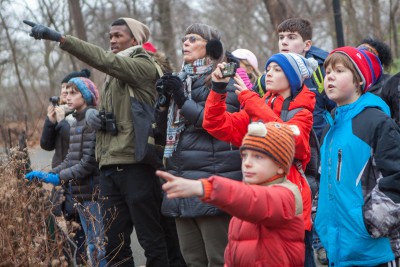It’s almost Christmas. ‘Tis the season of Black Friday and Cyber Monday, of parades and Christmas flotillas, of holiday gatherings to feast on turkeys and to count them as they roam though fields and woods.
Yes, it’s time once again for the annual Audubon Christmas Bird Count, and the N.C. chapter of the world’s foremost birding group invites birdwatchers to participate in the longest-running, citizen science survey. Beginning Monday, the state’s birders and nature enthusiasts will take part in the 116-year tradition of collecting information that will help shape the future of birds and climate science nationwide.
Supporter Spotlight
Each year, North Carolina ranks among the top performing states. During last year’s count, the state’s 51 participating geographic circles collected the most tallies of any state for 15 individual species. Among the most important species recorded in the state last year was the endangered red knot. Count participants recorded 1,600 knots along the coast including more than 1,200 on Ocracoke Island.

“The enthusiasm and dedication of CBC participants paves the way for Audubon’s groundbreaking research including our understanding of climate change and its effect on N.C. birds,” explained Heather Hahn, the state chapter’s executive director. “As Audubon continues to uncover the effects of climate change in our state, the data collected by these passionate supporters will pave the way for our work with local lawmakers to develop and enact legislation that protects our birds and our communities in the coming years.”
Each year, the Audubon Christmas Bird Count mobilizes over 72,000 volunteer bird counters in more than 2,400 locations across the Western Hemisphere. The count uses the power of volunteers to track the health of bird populations at a scale that scientists could never accomplish alone. Data compiled across North Carolina will record every individual bird and bird species seen in a specified area, contributing to a vast citizen science network that continues a tradition stretching back more than 100 years.
To date, more than 200 peer-reviewed articles have resulted from analysis done with Christmas Bird Count data. The counts are also critical to understanding how birds are responding to a changing climate. This documentation is what enabled Audubon scientists to discover that 314 species of North American birds are threatened by climate change as reported in Audubon’s groundbreaking Birds and Climate Change Study. The tradition of counting birds combined with modern technology and mapping is enabling researchers to make discoveries that were not possible in earlier decades.
“The CBC is a great example of the power of Audubon’s extended network,” Hahn added. “Today, participation is more important than ever as we seek to understand the health of our bird populations and find new ways to protect them. We encourage anyone interested in birding or bird conservation to find a nearby count and get involved.”
Supporter Spotlight
Birders of all ages are welcome to contribute to this fun, nationwide science project, which provides ornithologists with a crucial snapshot of our native bird populations during the winter months. Each individual count is performed in a count circle with a diameter of 15 miles. At least 10 volunteers, including a compiler to coordinate the process, count in each circle. The volunteers break up into small parties and follow assigned routes, which change little from year to year, counting every bird they see. In most count circles, some people also watch feeders instead of following routes.
The Audubon Christmas Bird Count began in 1900 when Frank Chapman, founder of Bird-Lore – which evolved into Audubon magazine – suggested an alternative to the holiday “side hunt,” in which teams competed to see who could shoot the most birds. For 116 years now, people have counted birds rather than shooting them.
The Audubon Christmas Bird Count is organized by the National Audubon Society. There is no fee to participate and the quarterly report of results, American Birds, is available online. Counts are open to birders of all skill levels and Audubon’s free Bird Guide app makes it even easier to chip in.








